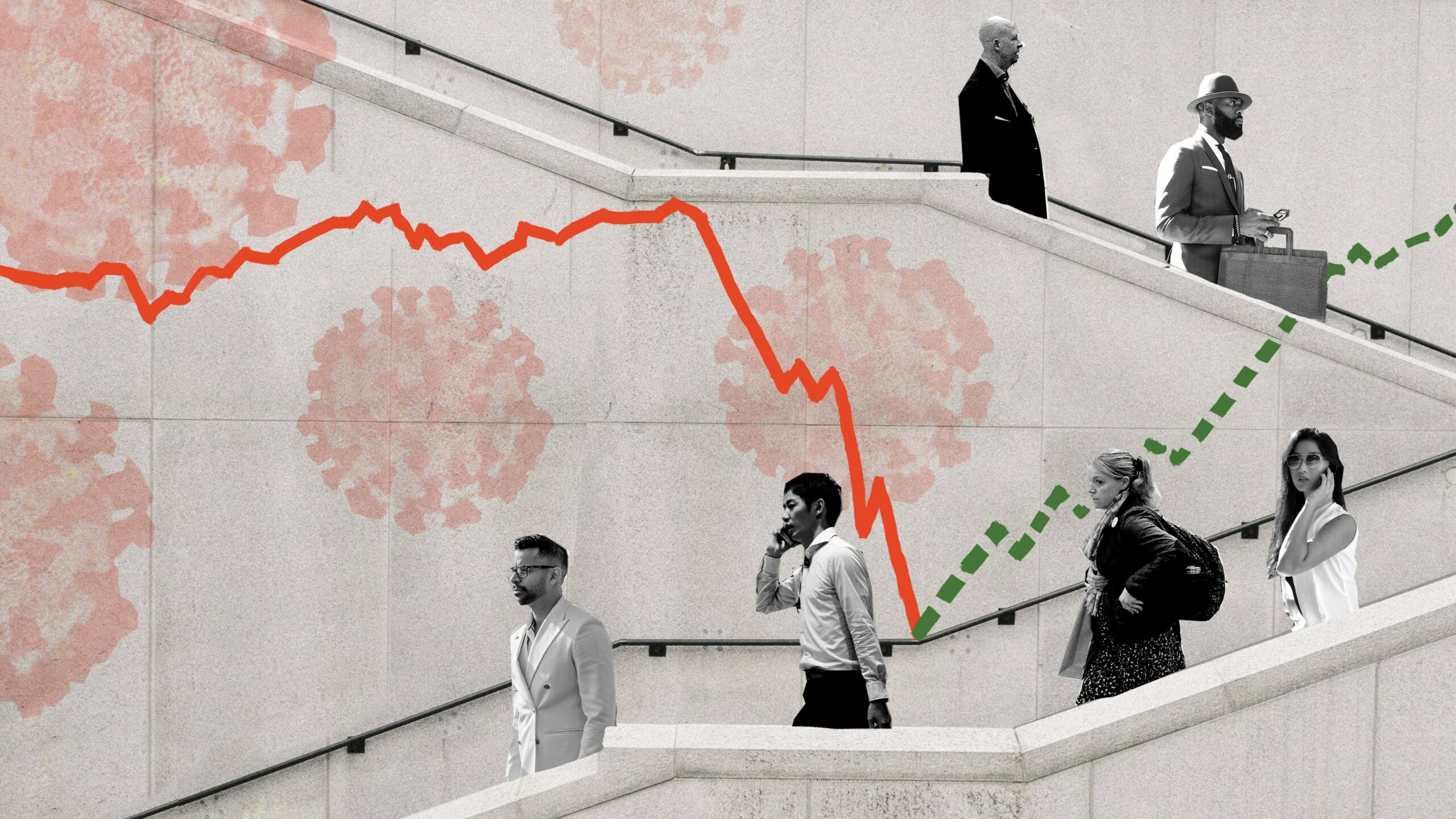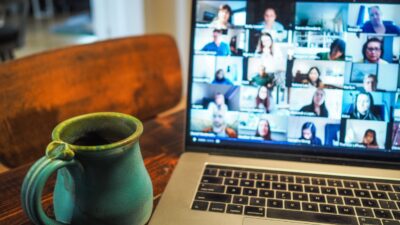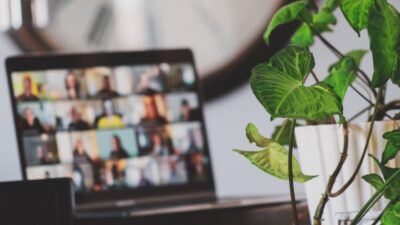Sandra Peter and Kai Riemer

Zooming on Corona Business Insights
Has Zoom saved the business meeting or are we zoomed out and fatigued? What digital enhancements will shape your Zoom appearance?
As COVID-19 sets out to change the world forever, join Sandra Peter and Kai Riemer as they think about what’s to come in the future of business.
Shownotes
Zoom took over the world, what will happen next
Your remote work persona deserves better
Why do we suffer from Zoom fatigue?
Stop zoning out in zoom meetings
How to elevate your virtual meeting presence
How to get people to actually participate in virtual meetings
Our previous specials on digital humans from Vivid Ideas 2018 and Vivid Ideas 2019
This episode is part of a podcast series covering what COVID-19 will mean for the business world, where we look at the impact on the economy, businesses, industries, workers and society. This is part of our ongoing coverage of the impact of COVID-19 on the future of business.
Follow the show on Apple Podcasts, Spotify, Overcast, Google Podcasts, Pocket Casts or wherever you get your podcasts. You can follow Sydney Business Insights on Flipboard, LinkedIn, Twitter and WeChat to keep updated with our latest insights.
Send us your news ideas to sbi@sydney.edu.au.
Dr Sandra Peter is the Director of Sydney Executive Plus at the University of Sydney Business School. Her research and practice focuses on engaging with the future in productive ways, and the impact of emerging technologies on business and society.
Kai Riemer is Professor of Information Technology and Organisation, and Director of Sydney Executive Plus at the University of Sydney Business School. Kai's research interest is in Disruptive Technologies, Enterprise Social Media, Virtual Work, Collaborative Technologies and the Philosophy of Technology.
Share
We believe in open and honest access to knowledge. We use a Creative Commons Attribution NoDerivatives licence for our articles and podcasts, so you can republish them for free, online or in print.
Transcript
Intro From the University of Sydney Business School, this is Sydney Business Insights.
Sandra And this is Corona Business Insights. I'm Sandra Peter.
Kai And I'm Kai Riemer.
Sandra And we're back unpacking the impact of COVID-19 on business, the economy, industry, government, workers and society and looking at the effects of the pandemic.
Kai And this podcast is part of a larger initiative by the University of Sydney Business School.
Sandra You can find our COVID business impact dashboard online at sbi.sydney.edu.au/coronavirus.
Kai And today we talk about zooming.
Sandra And of course, we have to talk about zooming during the pandemic because it's one of those few words that has moved from being a tech company, Zoom, much like Google, to becoming a verb, to 'zoom' someone.
Kai Yeah, we're not even FaceTiming people a lot these days, or call them on the phone. Everything's become 'zooming'.
Sandra So we'll talk a bit about Zoom the company but also about the practice of video conferencing, zooming. Because Zoom really has been hailed as one of these pandemic success stories, and of course, as we have all gone to work from home, we've all started getting on our Zooms, even though some of us got on Webex or on Teams or on other platforms.
Kai Yeah, we're still zooming on Teams. Yeah, that's not great for Microsoft is it?
Sandra It has actually been a really good time for Zoom. Their daily meeting participants have gone up to about 300 million at its peak in April when we had all gone home.
Kai And that's up from about 10 million on a normal day before the pandemic, mind you Zoom was originally an enterprise company selling its services mostly to businesses, but now has become a household item. They launched a free version allowing everyone to engage in free zooming, time-limited, not with the full feature set, but it has really become the household staple for checking in with friends overseas and doing just about anything.
Sandra And really that has seen the time we spend on Zoom alone go up from about 100 billion minutes at the end of January to about 2 trillion minutes in April.
Kai That's annualised meeting minutes. That's a lot of minutes in a year.
Sandra That's also a lot of money for Zoom, which had 169% increase on its reported total revenue by April of this year.
Kai Which means that shareholders such as Salesforce, who have just off-loaded Zoom from their portfolio, tripled their investment since Zoom went public in 2019.
Sandra And again, let's not forget Zoom is not a new company, it was founded in 2011. And it did go public in 2019. But it has gained huge popularity, both in the world of work, and for many becoming the social lifeline for keeping in touch with family, friends, many of whom have been out of reach during the pandemic.
Kai And the reason is, of course, that they have made it as easy as possible to do video conferencing, you don't need expensive hardware, you don't need to install any cumbersome software, Zooming is possible with just a link that someone sends you. And that ease of use has come at the expense of some security issues which the company has worked tirelessly to fix, but it's really the most straightforward way to initiate a group conference with other people.
Sandra And there have been a number of associated terms and practices that have crept up alongside zooming or video conferencing, more generally. One of them has been 'Zoom fatigue'.
Kai The jury's still out as to what causes Zoom fatigue, some say it's due to the sound quality. If you're in a room everyone kind of sounds the same, but people have very different microphones, very different internet connections or sometimes it's really hard and takes a lot of concentration to listen to what someone is saying.
Sandra Others say it's because it's difficult to get the body language and other contextual cues like facial movements or shifting posture that normally we would get in a face to face conversation, we now spend our time constantly scanning a grid of small rectangles to see whether people are understanding what they're saying what their feedback is. So we're ending up paying a lot more attention and doing that constantly. Hence, zoom fatigue.
Kai Which brings us to an emerging industry of Zoom advice and Zoom self-help. So in preparation for this podcast, we googled Zoom and look at the news items. And while there are some articles about Zoom the company or competitors positioning themselves to catch up with Zoom. There's a lot of items there that provide help for how to do Zoom right. There's even articles about the perfect hairstyle for zooming, using virtual backgrounds you don't want your hair to disappear.
Sandra Zoom shirts, Zoom sweatpants,
Kai There's a whole bunch of articles on our favourite management self-help portal Harvard Business Review, with titles such as "Stop Zoning Out in Zoom Meetings', 'How to Elevate Your Presence in a Virtual Meeting', 'How to Get People to Actually Participate in Virtual Meetings', usually with seven steps to a better Zoom experience. With advice such as do something in the first 60 seconds of a Zoom meeting to engage people, that people shouldn't hide, leave your video on, never go longer than five minutes without giving the group another problem to solve. So a lot of hands-on advice for what supposedly to do to reduce your Zoom fatigue and make your business meeting a success.
Sandra To be fair, there was one thing that I found particularly interesting coming out of MIT, and this was Sherry Turkle, who's a professor of Social Studies of Science and Technology at MIT.
Kai We like Sherry Turkle. She does really good research around online personas and things like that.
Sandra Sherry Turkle observes that it's really difficult to make eye contact on Zoom. If you're actually making eye contact with the people on the screen, it doesn't look to them as though you are because you're not looking straight at the camera. So in order to give the illusion of eye contact, on a Zoom call, you actually have to be staring straight in the camera, which makes you feel completely alone because you can't see anyone else.
Kai Yeah. So ironically, by making eye contact with people, you're not making eye contact with people, which kind of defeats the purpose. So now you can decide whether you want to read someone's facial expression or want to look engaged for them. So someone should solve this problem, potentially by embedding the camera straight into the screen. So there's an engineering challenge.
Sandra But of course, there are many other problems that come with being constantly in Zoom meetings, things like digital presenteeism that often creeps in where everyone has to be on a Zoom and be seen to be online all the time, even though they might not need to be present in those meetings or be present online. There is also all of the efforts that we've discussed in our remote work and productivity episode around the effort required to reproduce those serendipitous moments that happen in the hallways or at the water cooler, which now have to be engineered, again in Zoom sessions.
Kai And that's a real problem. I mean, if you think about it, it's been for so long that people have decried the amount of meetings that people are in when you're in the office and working from home has been touted as a really good way to get out of this cycle of meetings that people were having in the office. But according to some studies, we've actually made it worse because now what used to be a simple walk into someone's office or a simple phone call, becomes a scheduled zoom meeting. And so people are spending an enormous amount of time in Zoom meetings. I for one, spend way more time in meetings now that I work from home than I ever used to being in the office because everything takes so much more effort and deliberate scheduling.
Sandra And indeed a new study on the nature of work during the COVID pandemic. And we'll put all the links in the shownotes. They were looking at 3.1 million people, around 21,000 companies across 16 cities in North America, Europe and the Middle East, have found that not only is the workday a lot longer than before the pandemic that is, according to their study, 48.5 minutes longer, but the number of meetings that people are in increased by about 13%. And also people send a lot more emails per day to their colleagues.
Kai Yeah, also not a great development. But one thing that I'm interested in is where do we go from here? So if we think back the first few weeks of the pandemic, everything was kind of weird and messy and kind of homey, you know, people in sweatpants and the dog in the background and children running around, and we were all very forgiving that things were authentic. And you know, we got a glimpse into people's homes, and trying to decipher what's in people's backgrounds. And so as we will probably spend more time on Zoom going forward as we do already, what will actually happen to our appearance on Zoom? Will we declutter our backgrounds? Do we use virtual backgrounds? Or will we change the way in which we decorate our houses? Will we create a nice study which has an actual bookshelf in the background? So where are we going with this?
Sandra As I've mentioned before, on the one hand, there's all the self-help, even going as far as some people calling for the redesign of our homes, not just of our online personas. But on the other hand, there seems to be an increasing push from some companies including Zoom to professionalise our appearance from the app itself. Probably a more likely and way more cost-effective solution. So we've seen that Zoom already does manipulate the video to make you look better. They've recently introduced a new feature with the recent update that allows for adjusting skin smoothing and brightness in the video setting or adjust for low light options or dim the surrounding sound from the environment. And of course gives you the option of an eyepatch.
Kai Yeah, so there's nice and funny filters. You can be a pirate now, or wear a halo or, you know, some flowers in your hair. But more serious improvements include a noise filter that filters out background noise, playing children or barking dogs can now be suppressed. There's new visual reactions that people can use to engage in meetings when it's not their turn to speak. And so Zoom is showing us a glimpse of what will be possible and how they intend to actually shape your appearance digitally without having to redecorate your house, without necessarily having to provide the best lighting yourself. They will want to do a whole lot of things for you. Of course, they can't fix the camera angle yet. So if you are zooming from an iPad that is lying flat on the table, it will still show your nose hair.
Sandra Speaking of noses Kai, you might want to pick a different nose or even a different face or maybe soon in the future, a different accent or the ability to speak a different language altogether.
Kai So with advances in what's called neural rendering, digital humans, deep fakes, we're not far off from you know, picking a different face. So the question is, where does it end? And where are the social norms going off what is acceptable and appropriate in a business context? While you know wearing an eyepatch or a party hat is fun for a couple minutes or in a social context. It's not really where the serious improvements will lie. But since digital improvements can now extent to all aspects of your digital appearance. This is a really interesting space to watch.
Sandra And whilst will include all the links to our conversations around digital humans, avatars, and deep fakes in the shownotes, this is all we have time for today.
Kai This has been Corona Business Insights.
Sandra Thanks for listening.
Kai Thanks for listening.
Outro From the University of Sydney Business School, this is Sydney Business Insights, the podcast that explores the future of business.
Close transcript





